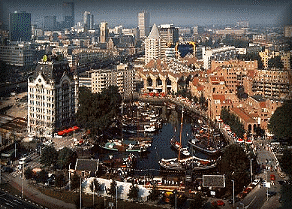| Oude Haven (Old Docks) |
|
The Oude Haven has every right to call its self the
oldest dock of Rotterdam. In 1351 the first jetty was built here. In the
centuries that followed the area developped and many warehouses The Oude Haven is connected to the Haringvliet. This dock was created between 1575 and 1592 during another expansion of the city. It derives its name from the hering fleet that used to have its base here. On its south bank are a number of student housing block and a couple of old merchant homes. The Spanjaardbrug (Spaniards Bridge) connects the Spaansekade with the Oude Hoofd square. The first bridge was built in 1597. The bridge got its present name in 1608 when the spanish general Spinola and his entourage visited Rotterdam. He was on his way to the Hague for negotiations on the 12 year cease fire during the Eighty Year War (1588-1648) with Spain. The present bridge dates back to 1890. Pay also attention to the advertising pillar of 1894. An innovation in outdoor advertising of which Rotterdam erected 16 at the time. The White House is een eye catcher too. It was built in 1898 by Molenhoek and with its 45 metres height it was the tallest building in continental Europe. The outside is adorned with Art Nouveau decorations. Watch out for the six pictures in its facade depicting Labour, Progress, Industry, Trade, Agriculture and Navigation.
|
| Cubic houses |
|
This complex (1978-1984), built over the
Blaak near the Old Docks, is a creation by Piet Blom, who built a similar
construction in Helmond. Under the cubes is a indoor street with shops and
offices. The houses themselves have only tilted walls and offer relatively
little space to live in. But it's unique and centrally located. One of the
cubes is open to visitors. |
 and merchant homes were built along the Gelderse kade. In 1940 the area was
completely leveled by German bombs. The redevelopment of the area was awarded to
architect Piet Blom in 1977. The area is part of Waterstad, the first expansion
of the little town that Rotterdam was in the early 16th century. These
days it is a lively place with an emphasis on nightlife. The dock itself now
serves as an open air museum for historic ships. On the southern end a historic
(working) ship yard has been reconstructed.
and merchant homes were built along the Gelderse kade. In 1940 the area was
completely leveled by German bombs. The redevelopment of the area was awarded to
architect Piet Blom in 1977. The area is part of Waterstad, the first expansion
of the little town that Rotterdam was in the early 16th century. These
days it is a lively place with an emphasis on nightlife. The dock itself now
serves as an open air museum for historic ships. On the southern end a historic
(working) ship yard has been reconstructed.